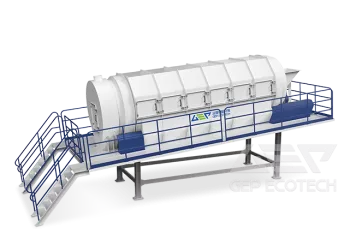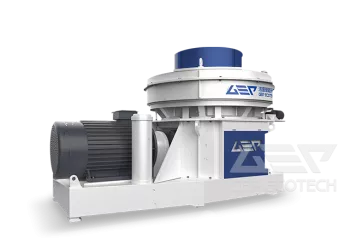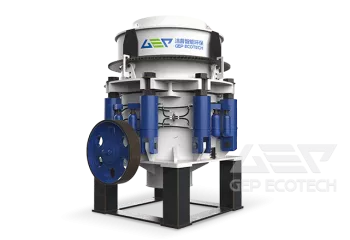In waste disposal, tertiary shredding systems offer significant advantages over single-stage or dual-stage systems, primarily in the following areas:
1. Processing Efficiency and Shredding Effect
Optimized Shredding Ratio:The three-stage system progressively reduces material size through sequential primary, secondary, and fine shredding. This segmented approach prevents overloading a single-stage machine and enhances overall efficiency.
Finer and More Uniform Particle Size:Tertiary shredding produces a narrower particle size distribution (e.g., <10mm), facilitating subsequent processes such as sorting, incineration, or resource recovery. For instance, metals and plastics become easier to separate after fine shredding, while incineration efficiency improves due to better fuel combustion.
Adaptability to Complex Materials:Tertiary systems can selectively target materials of varying hardness (e.g., metal, plastic, wood) in mixed waste streams like construction debris or e-waste. This reduces "over-shredding" of softer materials and "under-shredding" of harder ones.
2. Equipment Longevity and Maintenance Costs
Reduced Wear and Tear:Each shredding stage is optimized for a specific task, minimizing stress on individual machines. For example, a jaw crusher handles large materials while a fine hammer crusher processes smaller particles, extending the lifespan of both.
Longer Maintenance Intervals:In a three-stage system, fine shredding equipment only handles pre-crushed material, reducing wear by 30%-50% compared to dual-stage systems, thus lowering maintenance frequency and costs.
3. Energy Consumption and Environmental Performance
Energy Optimization:Single-stage shredding requires high energy input to achieve the target size in one pass. In contrast, stepwise reduction in a three-stage system can lower total energy consumption by 10%-20%, especially when processing tough materials.
Enhanced Environmental Controls:Each stage can integrate dust and noise mitigation measures (e.g., enclosed fine shredding chambers and high-efficiency bag filters), reducing emissions and complying with stringent environmental standards.
4. Flexibility and Adaptability
Adjustable Processes:Shredding parameters can be fine-tuned based on material characteristics (e.g., moisture content and hardness). For example, when handling wood-heavy waste, the system can bypass the medium shredding stage and proceed directly to fine shredding.
Improved Resource Utilization:Finer shredding increases material surface area, facilitating advanced recycling methods such as pyrolysis of plastics or anaerobic digestion of organic waste.
5. Economic Considerations
Higher Initial Investment, Greater Long-Term Savings:While a three-stage system may cost 20%-30% more to purchase and install compared to a dual-stage system, its higher resource recovery rates and reduced operational and maintenance costs yield significant long-term financial benefits. For instance, a 5%-10% increase in metal recovery can offset the initial capital expenditure.
Recommended Applications
Tertiary Shredding Systems: Ideal for processing complex, heterogeneous waste requiring fine shredding (e.g., e-waste, industrial and hazardous waste, mixed municipal waste).
Dual/Single-Stage Systems: Suitable for simpler waste streams with larger target particle sizes (e.g., crushing concrete for aggregate production).
Conclusion
Tertiary shredding systems excel in processing efficiency, product quality, equipment longevity, and environmental compliance. They are particularly advantageous for high-standard waste recycling projects. Although the initial investment is higher, the long-term benefits make these systems indispensable for handling complex waste materials.
Case Study: GEP Ecotech's 100,000-Ton Waste Textile Alternative Fuel Project
The Yangtze River Delta's 100,000-ton waste textile-to-RDF fuel project, fully supported by GEP Ecotech, recently commenced operations. This innovative project converts waste textiles into refuse-derived fuel (RDF) for direct use in cement kilns, replacing traditional coal.
To address the challenges posed by the strong entanglement and complex composition of waste textiles, GEP Ecotech developed a comprehensive process:
Progressive Shredding:Utilizing a three-stage twin-shaft shredder with differentiated cutter designs (thick teeth for initial loosening, thin teeth for refinement, and precision blades for final shredding), the system significantly reduces energy consumption compared to conventional processes involving a dual-shaft shredder, single-shaft fine shredder, and RDF pelletizer.
Automated Iron Removal:An intelligent magnetic separation system captures 99% of metal impurities, protecting downstream furnace equipment from damage.
Compression Baling:Hydraulic balers produce compact, dense RDF bales for efficient storage and transportation.
Intelligent Operation and Maintenance:Real-time monitoring ensures precise process control, while automated fault detection and big-data analysis optimize system performance and decision-making.
GEP's advanced solution has improved fuel quality, reduced equipment failure rates, and lowered processing costs per ton. The three-stage shredding system maintains continuous, stable operation even when handling waste textiles with metal components like zippers and buttons, while ensuring the resulting RDF meets the calorific requirements for cement kiln combustion.





